


Scroll down to see all the illustrations on the page








Pages






Mk I Infantry Tank
The Mark I was the world's first true tank and was intended to
break the stalemate of trench warfare on the Western Front.
They were designed to withstand the machine gun and small
arms fire in ‘No Man's Land’, so they could goon and attack
enemy positions, and to achieve this a rhomboidal shape with
the tracks running round the outside was chosen as the best
solution to negotiate the terrain, barbed wire, and trenches,
and because of the height necessary for this shape the
armament was arranged in sponsons on the tanks’ side. Two
types were produced, the ‘Males’ were armed with a 6 pounder
S P E C I F I C A T I O N :
Vehicle Weight: 28 tons
Dimensions: Length 32 ft 6 ins, Width 12 ft 10 ins, Height 7 ft 11 ins
Powerplant: 1 x 150 hp Daimler petrol engine
Performance: Maximum speed 3.7 mph, Range 23 miles
Armament: 2 x 57 mm guns, 3 x 0.303 inch machine guns
Armour: Maximum thickness 12 mm
Crew: 8
cannon and three machine guns, while ‘Females’ were armed
with up to 6 machine guns only. They entered service in July
1916, and first used during the fighting on the Somme at Flers-
Courcelette on the 15th September, where 49 set out to attack
enemy positions, but only a few reached their objectives,
although these did manage to dislodge the terrified German
infantry from their trenches. The most successful was tank Dl
which reached the outskirts of Delville Wood and captured a
number of German soldiers, but was then disabled by a shell
hit making it the first tank casualty in history.

Country of Origin: UK
Number Built: 150
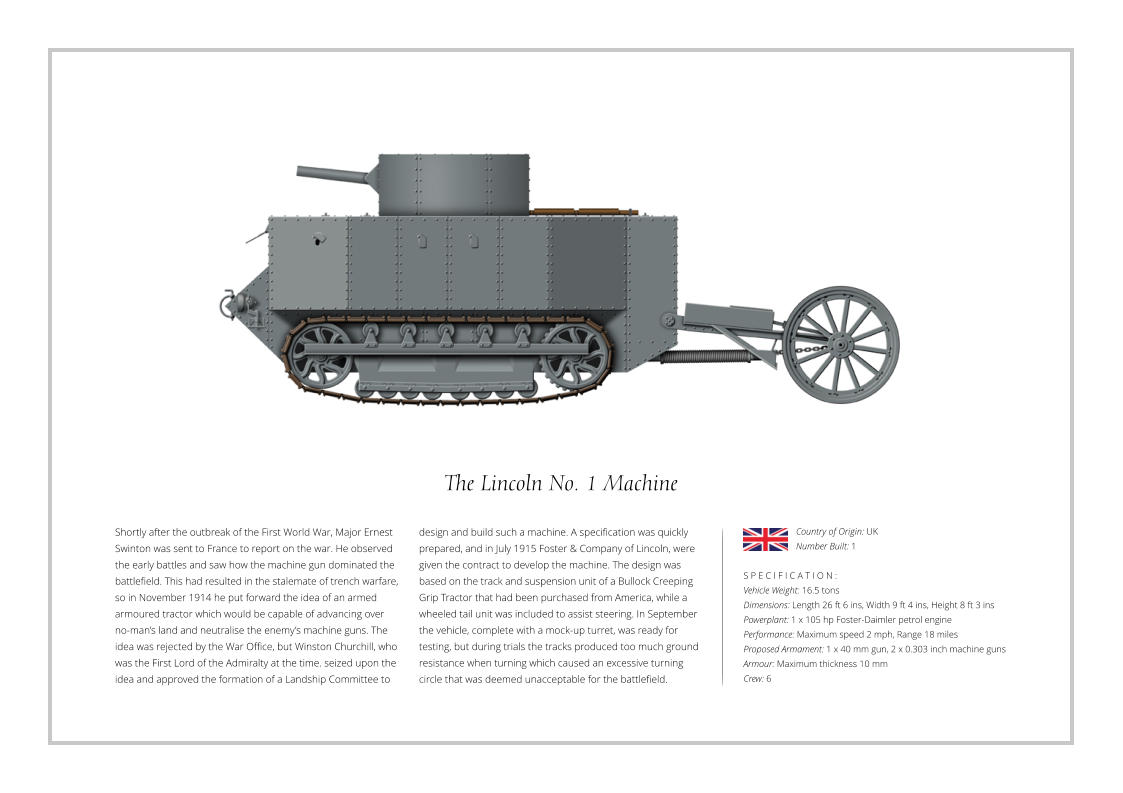
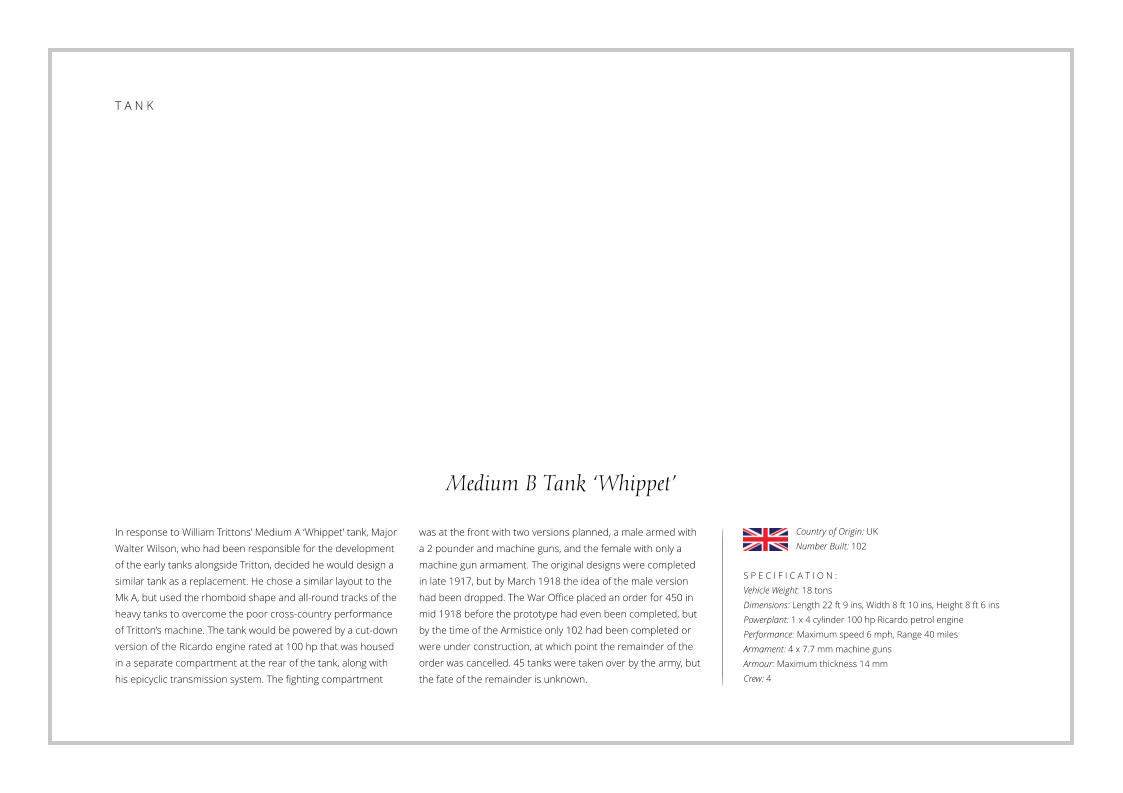
Mk VIII ‘International’ Tank
When America came into the war on the side of the Allies in
April 1917, the industrial powerhouse of that nation became
fully available for production of war material. In the U.S. they
had already been producing arms for the allies but had few
designs of their own. The Mk VIII ‘International’ tank (named
Liberty Tank by the Americans) was an Anglo-American
collaboration intended to equip the armies of the U.K., U.S.A.
and France for the planned offensives in 1919. Design work
began in 1917, and retained many features of the British Mk I-V
series, but with wider tracks and an increase in length to give
S P E C I F I C A T I O N :
Vehicle Weight: 37 tons
Dimensions: Length 34 ft 3 ins, Width 12 ft 4 ins, Height 10 ft 3 ins
Powerplant: 1 x Ricardo or Liberty 300 hp petrol engine
Performance: Maximum speed 5 mph, Range 30 miles
Armament: 2 x 6 pounder guns, 7 × 7.7 mm machine guns
Armour: Maximum thickness 16 mm
Crew: 10-12
the vehicle better trench crossing capability. The lessons of
earlier tanks had been learned, as the interior of the tank was
compartmentalised with a separate engine room at the back.
The tank was to be powered by a V12 engine, preferably the
300 hp water cooled V12 American Liberty engine. It was
planned that 4,500 tanks would be assembled in France from
hulls, armament and armour supplied from Britain and
American, with manufacture beginning in the Autumn of 1918,
but by the time of the Armistice in November only seven had
been built in the UK and one in the US.
Country of Origin: USA & UK
Number Built: 125
‘Little Willie’
To overcome the problems encountered with the Lincoln No 1
machine, the suspension unit was lengthened and modified
with a more curved bottom profile and the tracks redesigned.
As a cover for its intended use, a rumour was started that the
vehicle was a mobile water tank intended for the frontline
troops, and it is from this the word ‘tank’ became synonymous
for these types of armoured vehicles, even after their true role
on the battlefield had been revealed in 1916. On completion of
the modifications the vehicle proved to have better handling
and was promptly named ‘Little Willie’, a paronym of the
S P E C I F I C A T I O N :
Vehicle Weight: 16.5 tons
Dimensions: Length 26 ft 6 ins, Width 9 ft 4 ins, Height 8 ft 3 ins
Powerplant: 1 x 105 hp Foster-Daimler petrol engine
Performance: Maximum speed 2 mph, Range 18 miles
Proposed Armament: 1 x 40 mm gun, 2 x 0.303 inch machine guns
Armour: Maximum thickness 10 mm
Crew: 6
German Kaiser Wilhelm II. and in the autumn of 1915 was
paraded in front of high ranking officials of the War Office. In
the meantime work was already underway for a successor to
Little Willie, and following a suggestion in the summer design
work had commenced for a tank that had tracks that ran all
around the vehicle on a rhomboid frame. This was later named
‘Mother’ and became the prototype for the Mk I infantry tank
which were first used during the Battle of the Somme in 1916.
Little Willie was preserved for posterity after the war, and is
today on display at The Bovington Tank Museum.

Country of Origin: UK
Number Built: 1
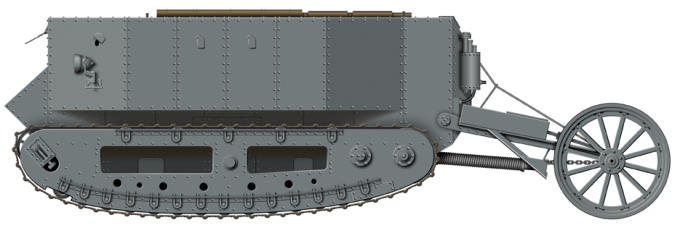


T A N K
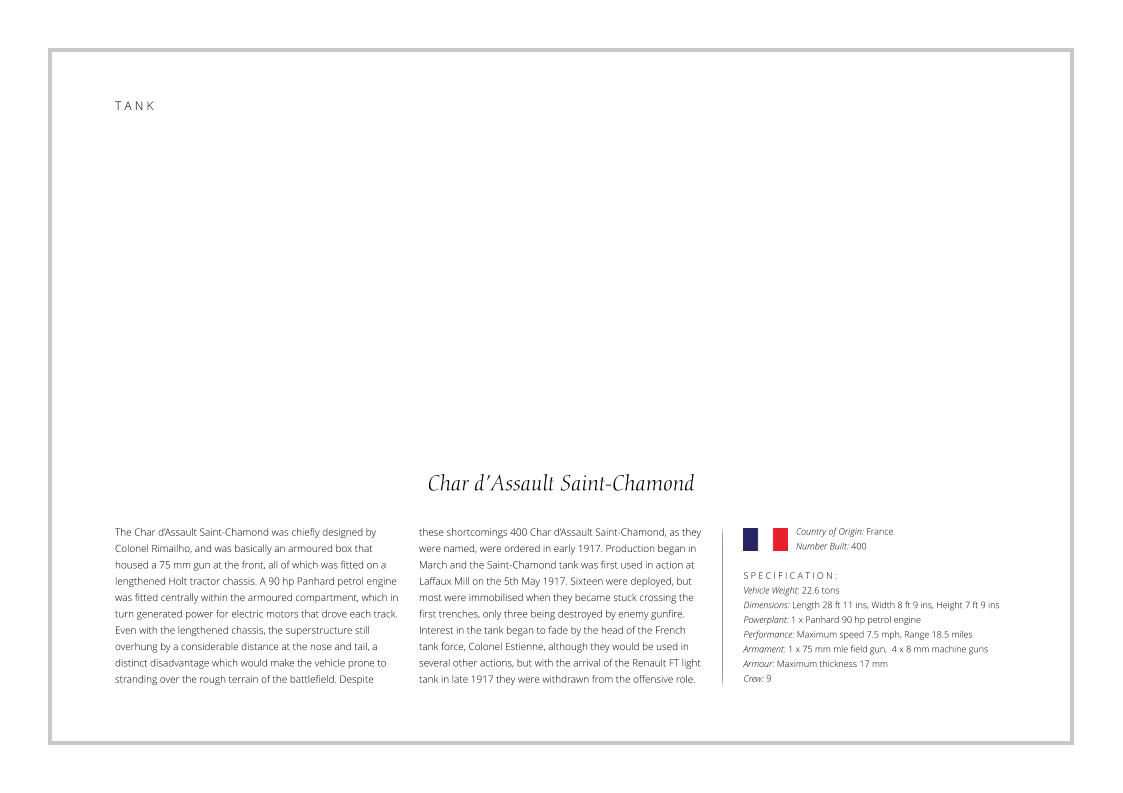
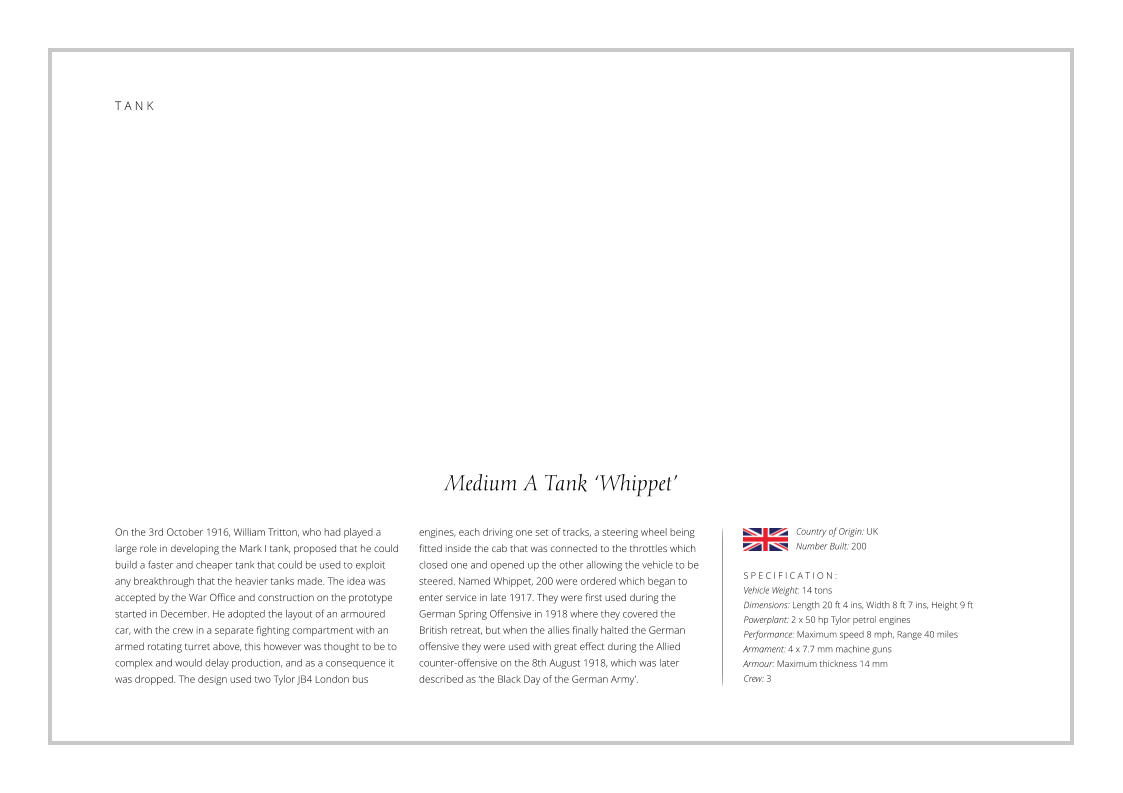
T A N K
T A N K
T A N K
Renault FT17 Light Tank
The Renault FT17 light tank came about mainly through the
persistence of the French Army Colonel Jean-Baptiste Estienne,
the design of which would influence tanks for nearly a century.
It was designed as a lightweight tank that offered better
mobility and speed than the lumbering medium and heavy
tanks in service with the allies. They were the first use of a fully
rotating turret armed with a 37 mm cannon or an 8 mm
machine gun which reduced the need to duplicate the
armament, while the engine was mounted in the rear of the
hull. They required a crew of only two, the driver at the front
S P E C I F I C A T I O N :
Vehicle Weight: 7.2 tons
Dimensions: Length 16 ft 5 ins, Width 5 ft 9 ins, Height 7 ft
Powerplant: 1 x Renault 39 hp petrol engine
Performance: Maximum speed 5 mph, Range 37 miles
Armament: 1 x Hotchkiss 8 mm machine gun or 1 x 37mm gun
Armour: Maximum thickness 22 mm
Crew: 2
and the commander behind in the turret who also manned the
gun. Despite its advanced design Renault had difficulty in
getting approval for the vehicle, but were finally allowed to
place the FT17 into production, but by the end of 1917 only 84
had been produced, although a further 2,613 would be
delivered in 1918, and in total 3,694 were eventually built in
France, with a further 950 under license in the U.S.A. The FT17
was first used in action on the 31st May 1918, the type proving
to be highly capable machines, with 550 still listed as being on
strength with French forces in 1939.
Country of Origin: UK
Number Built: 4,644
T A N K

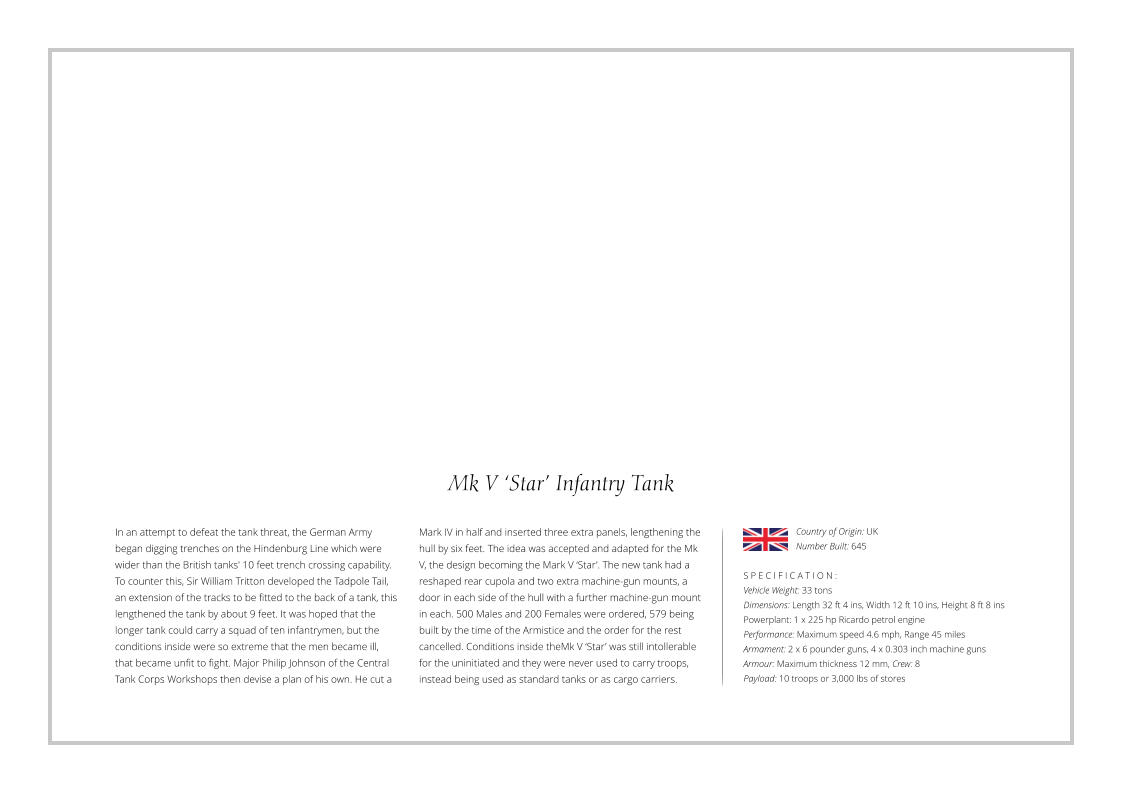
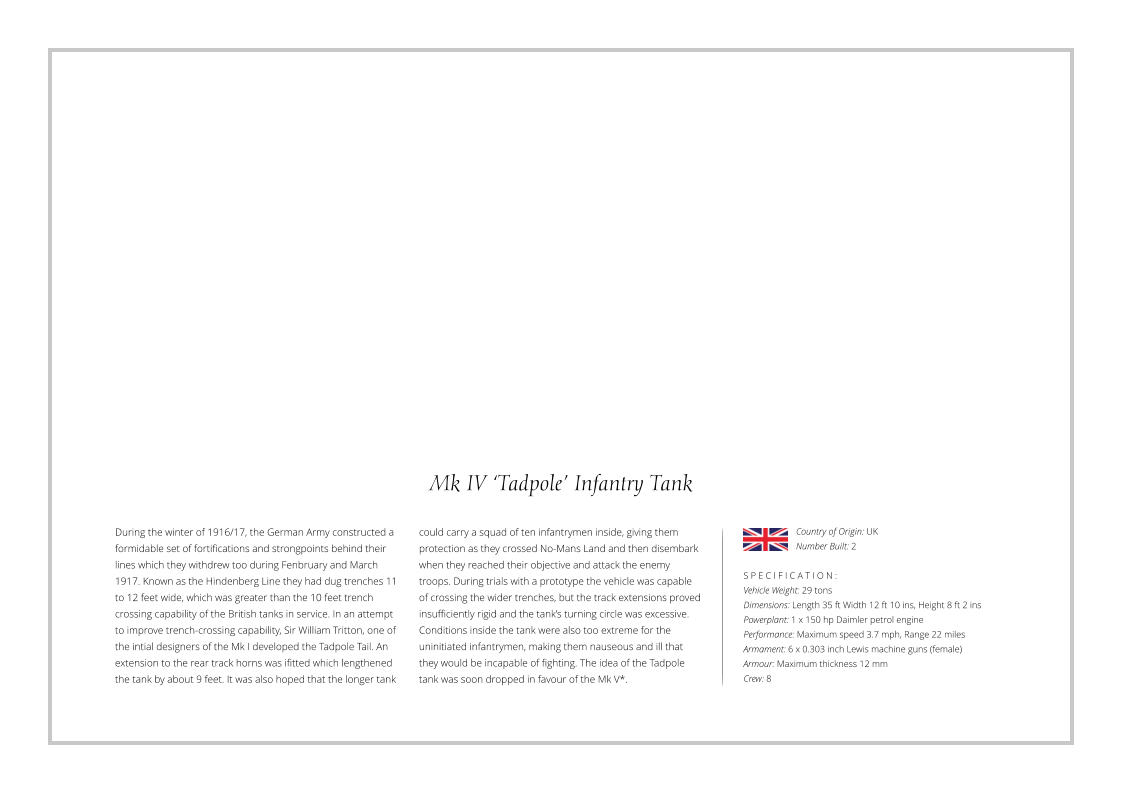
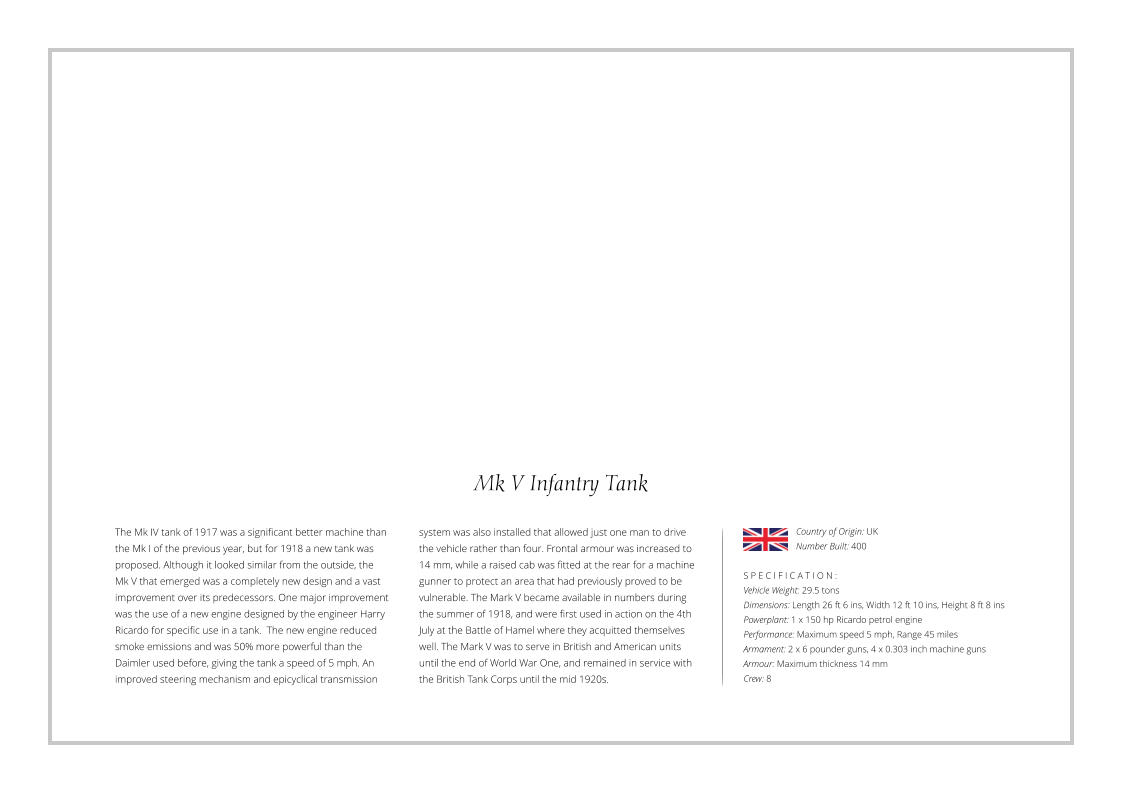
T A N K
T A N K
T A N K
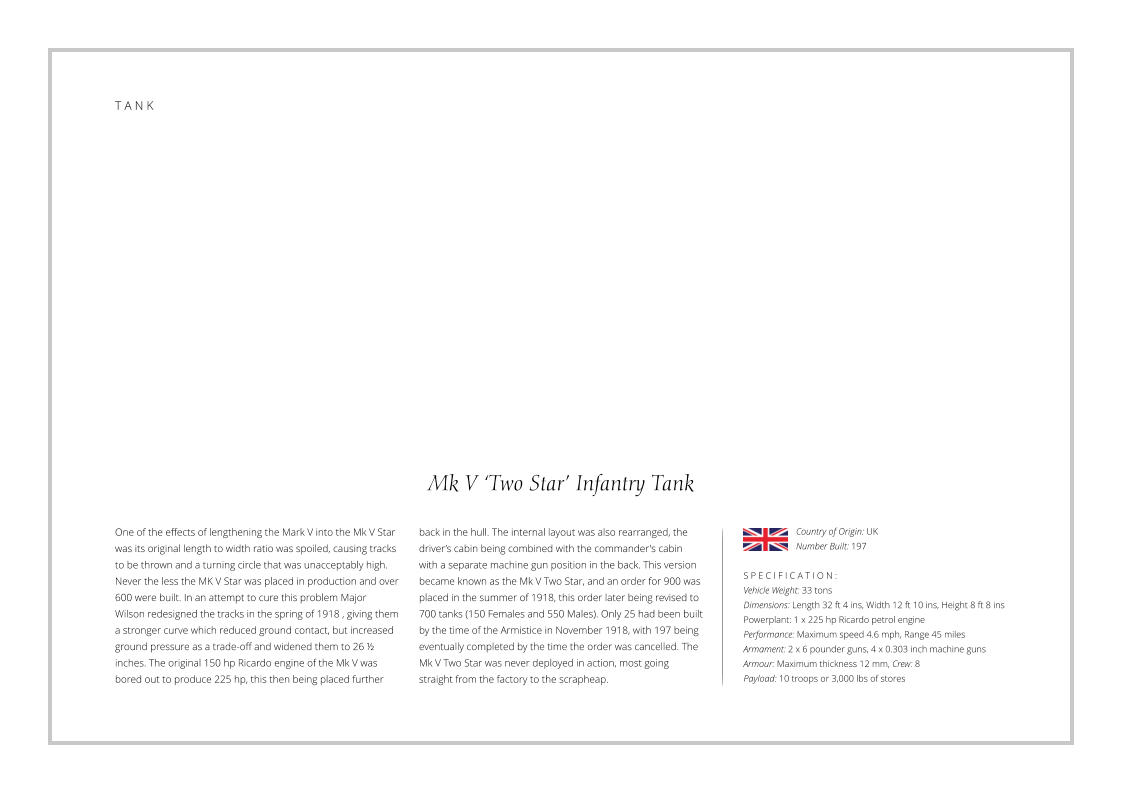
Sturmpanzerwagen A7V
After German troops encountered British tanks for the first
time in September 1916, the German High Command set
about on a tank of their own which resulted in the A7V. The
design was based on the running gear of the American Holt
tractor on which a large box compartment was fitted that
housed the crew, engine and armament that consisted of a 5.7
cm cannon and six machine guns. Protection was provided by
30 mm steel plates to the front, 20 mm plates to the sides, and
10 mm for the roof, however the steel was not hardened and
was only proof against machine gun and rifle fire. Eighteen men
S P E C I F I C A T I O N :
Vehicle Weight: 32 tons
Dimensions: Length 24 ft 1 ins, Width 10 ft, Height 10 ft 10 ins
Powerplant: 2 x Daimler-Benz 100 hp petrol engines
Performance: Maximum speed 9 mph, Range 50 miles
Armament: 1 x 5.7 cm cannon, 6 x 7.92 mm machine guns
Armour: Maximum thickness 30 mm
Crew: 18
were required to man the tank, fourteen of which manned the
cannon and six machine guns. The prototype was completed in
early 1917 abut during trials it was soon apparent that the
design lacked the ability to operate on the western front, easily
becoming stuck in any type of heavy ground. The German High
Command were aware that they did not have time to produce
an improved design, so in late 1917 they placed an order for
100 but only one third built, and only twenty of these were
armed. The A7V was first used in action on the 21st March
1918 at the start of Ludendorff’s Spring Offensive.
Country of Origin: Germany
Number Built: 20


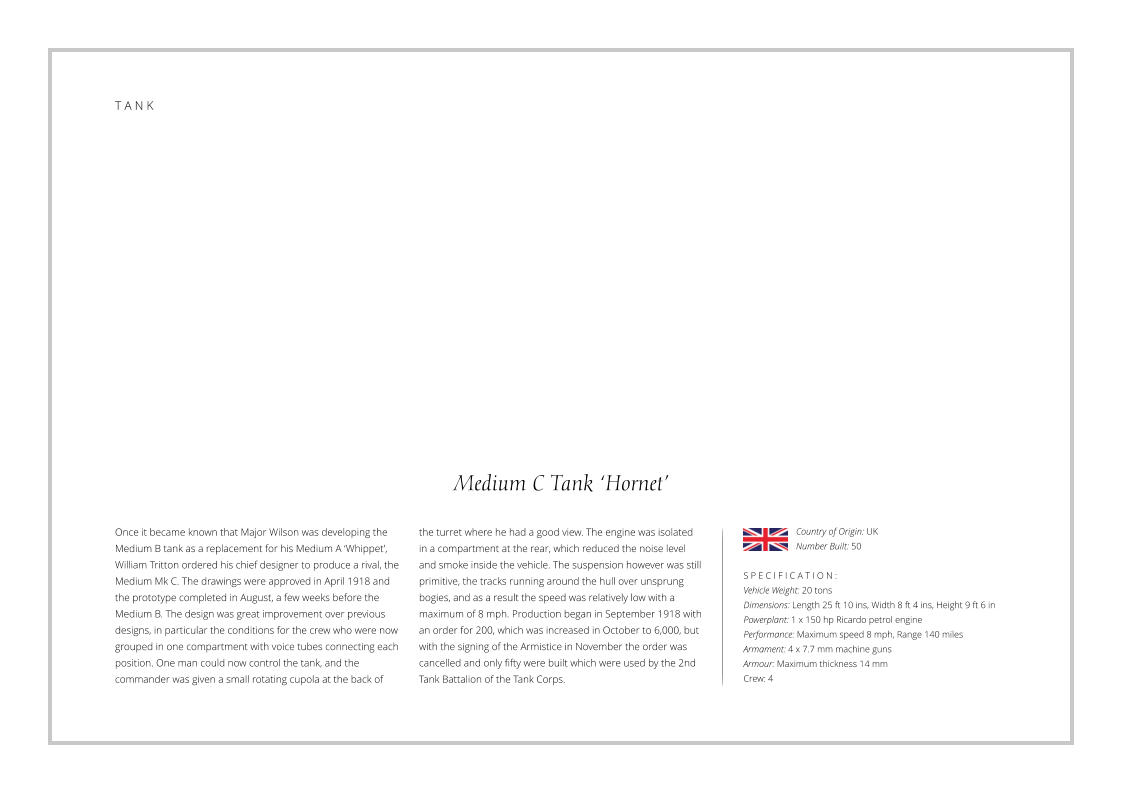
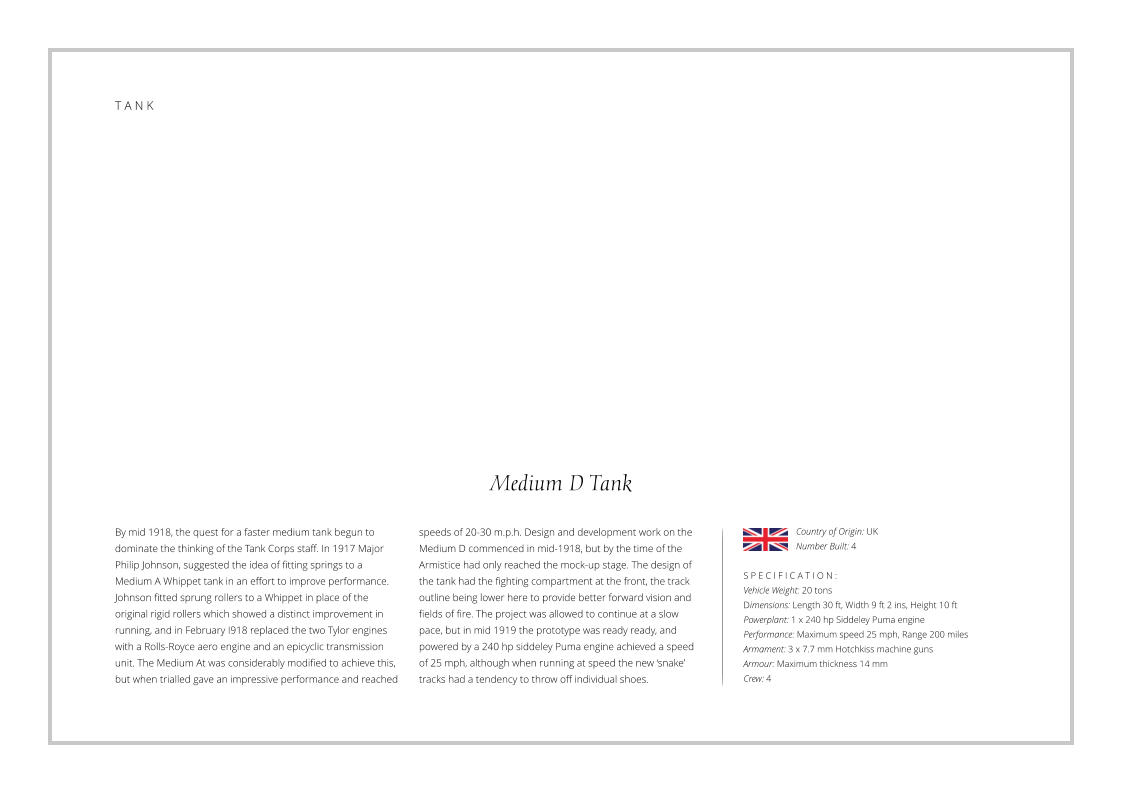
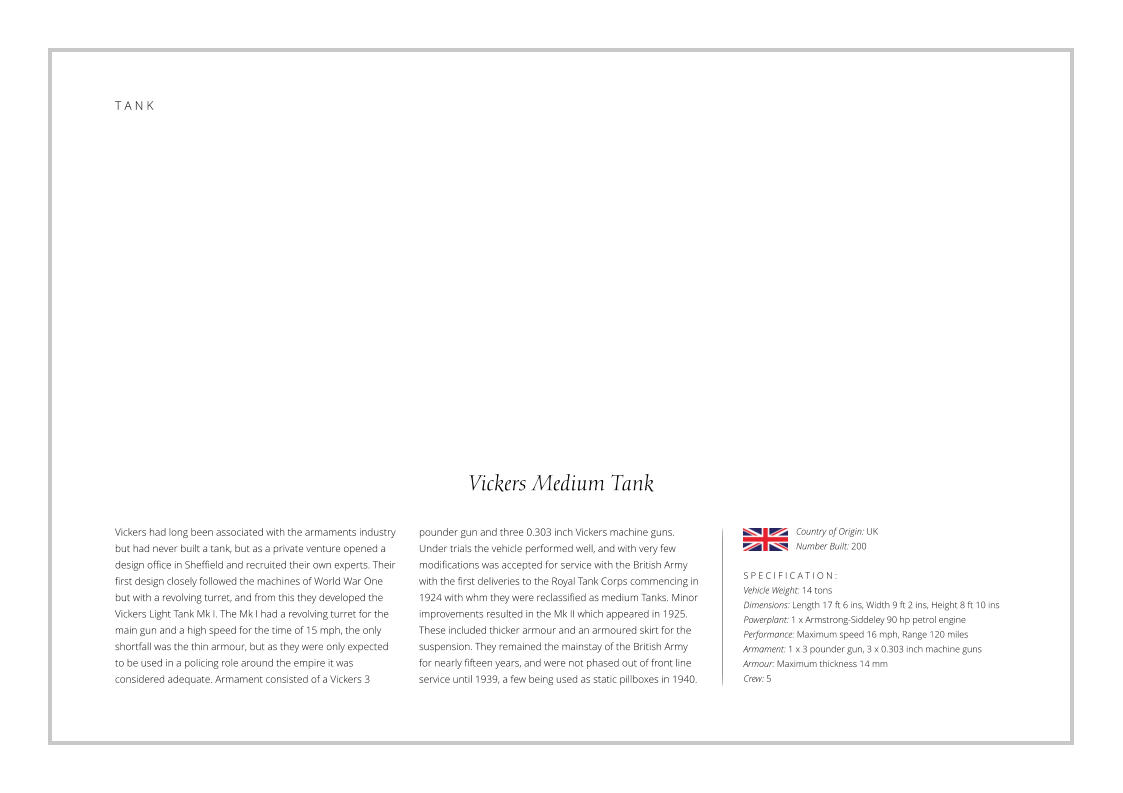
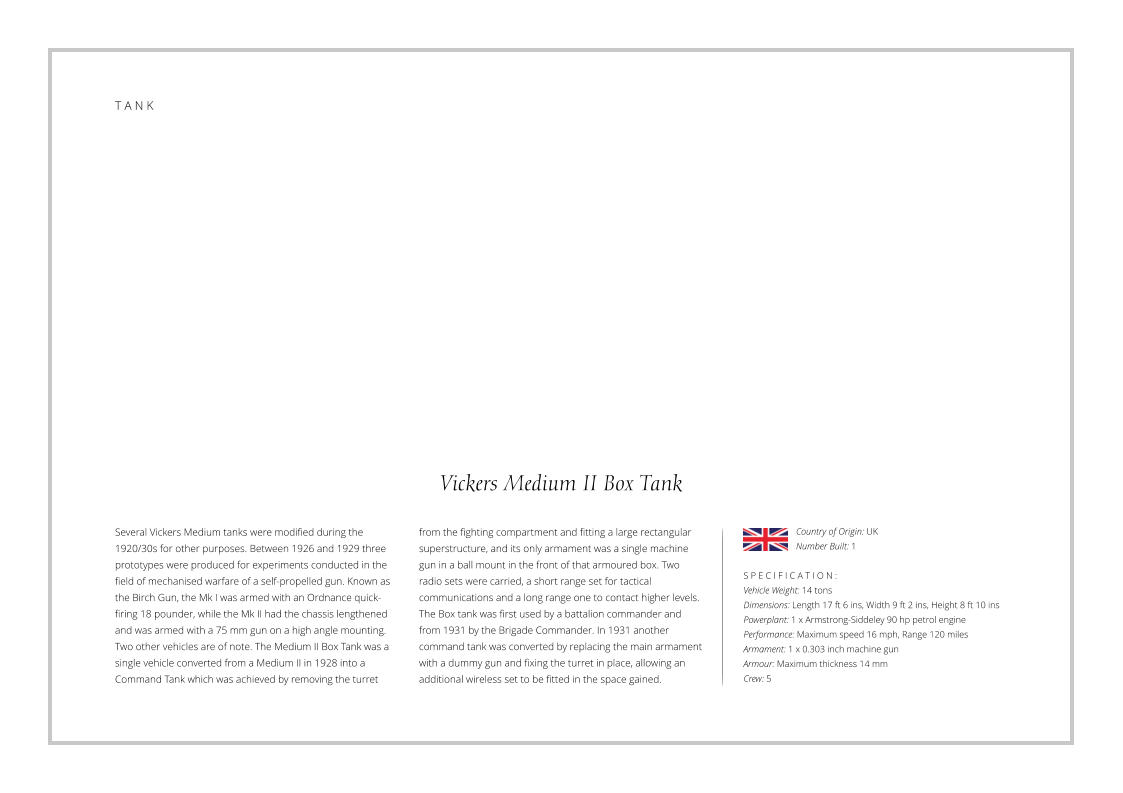
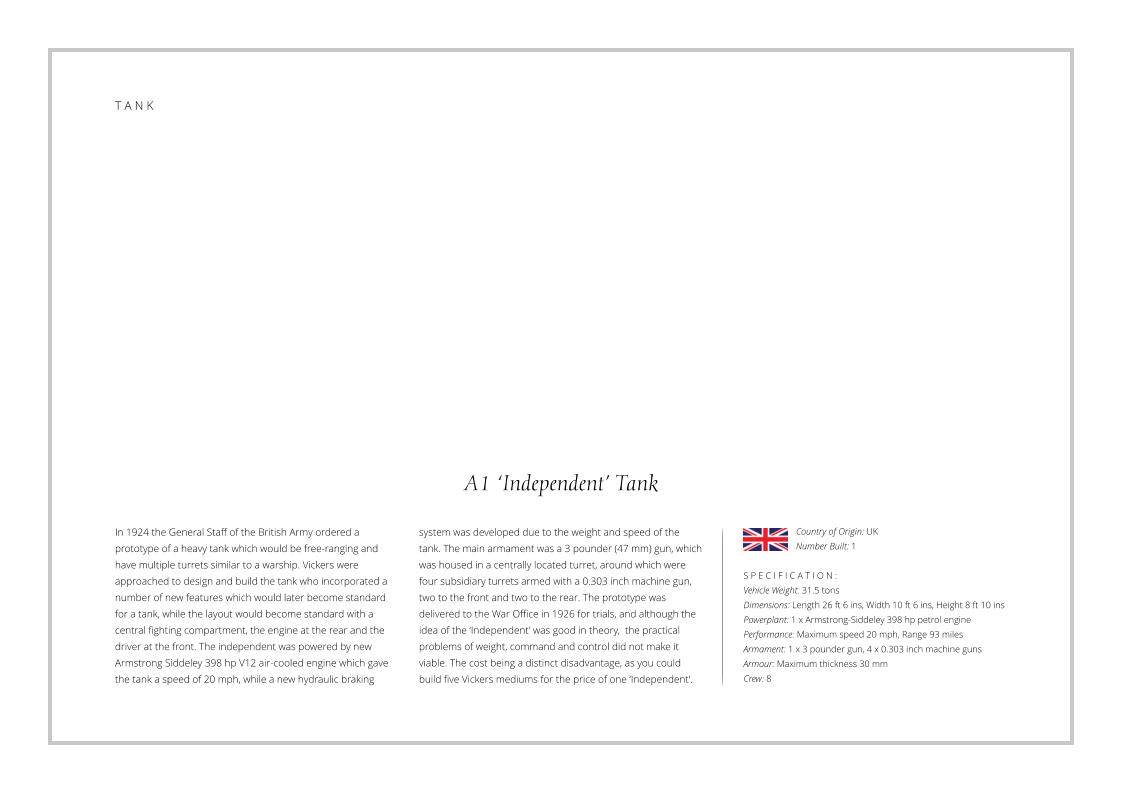
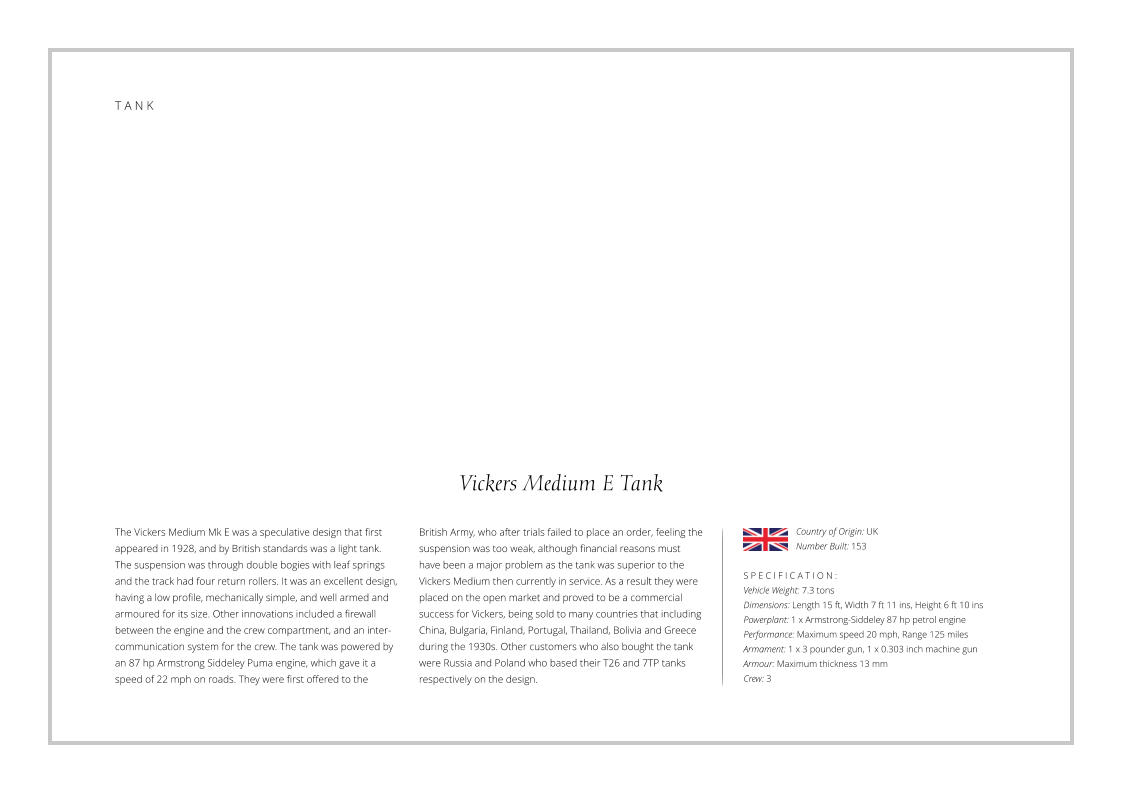
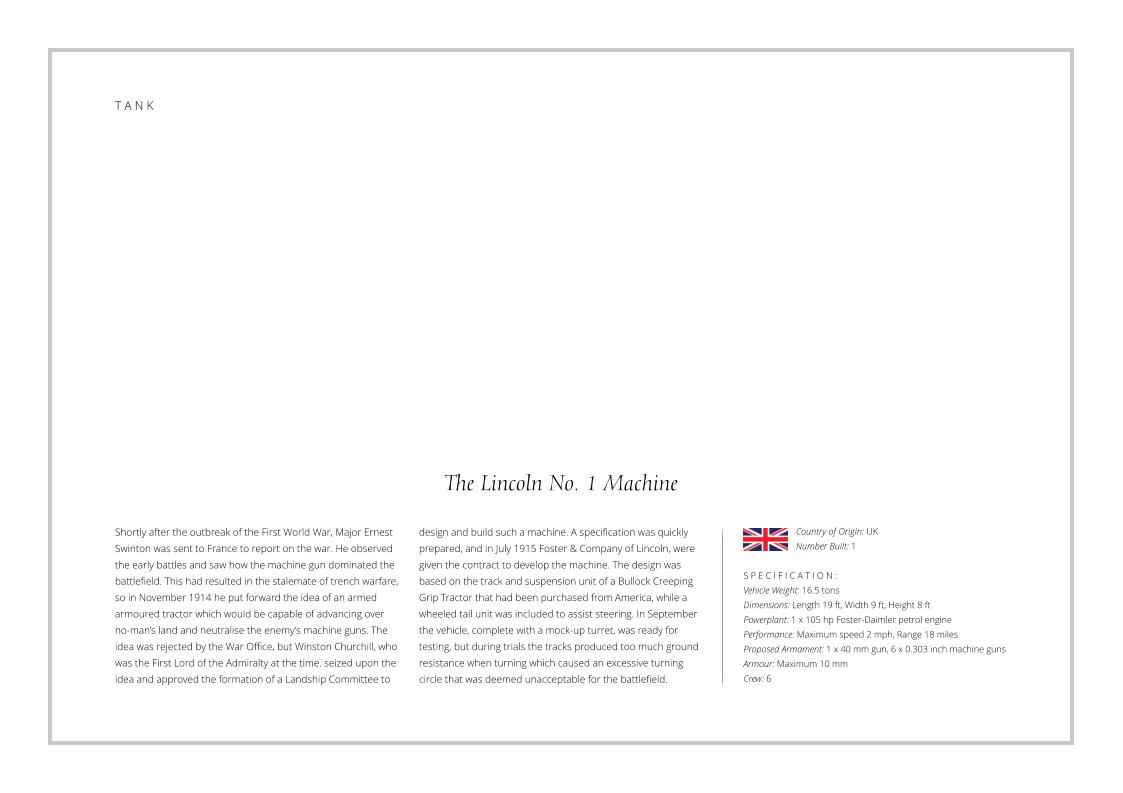
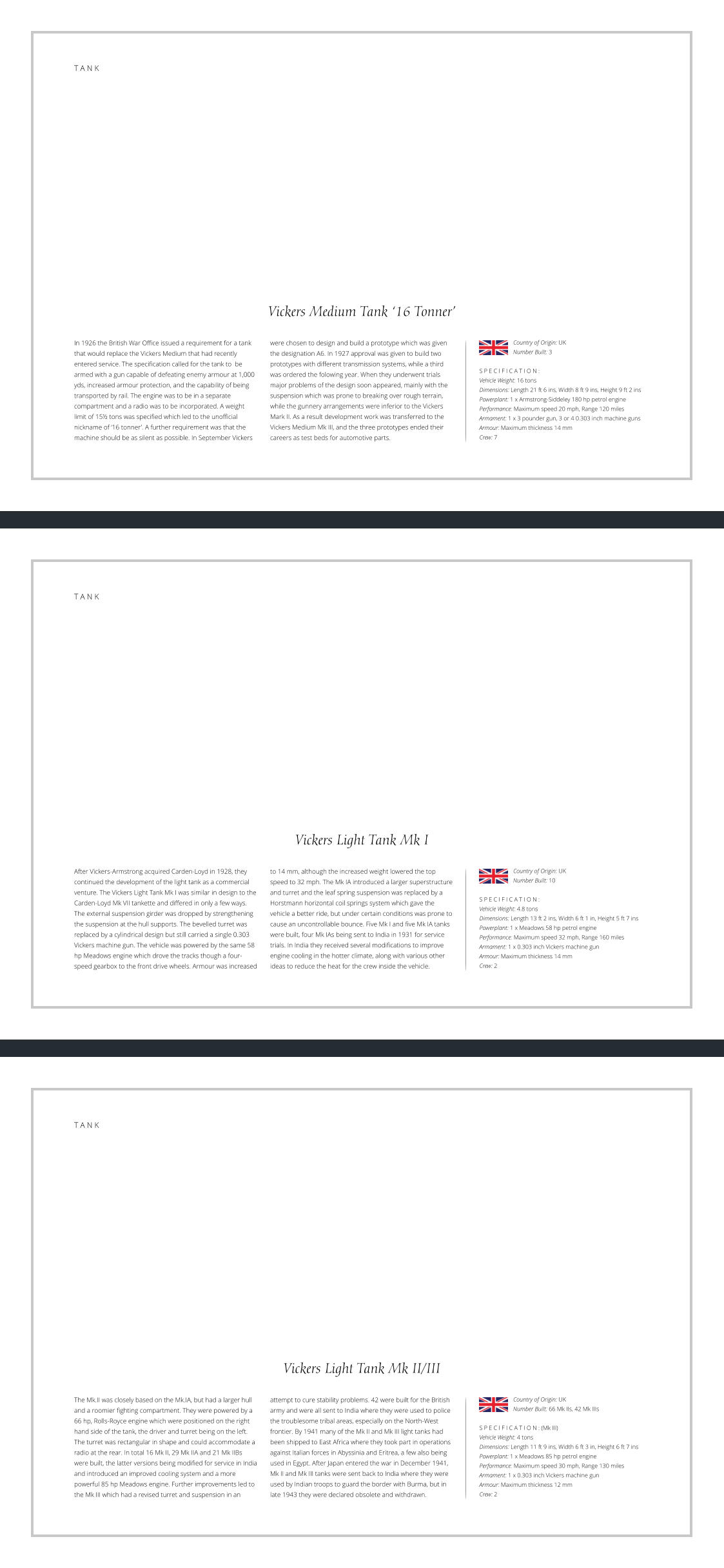
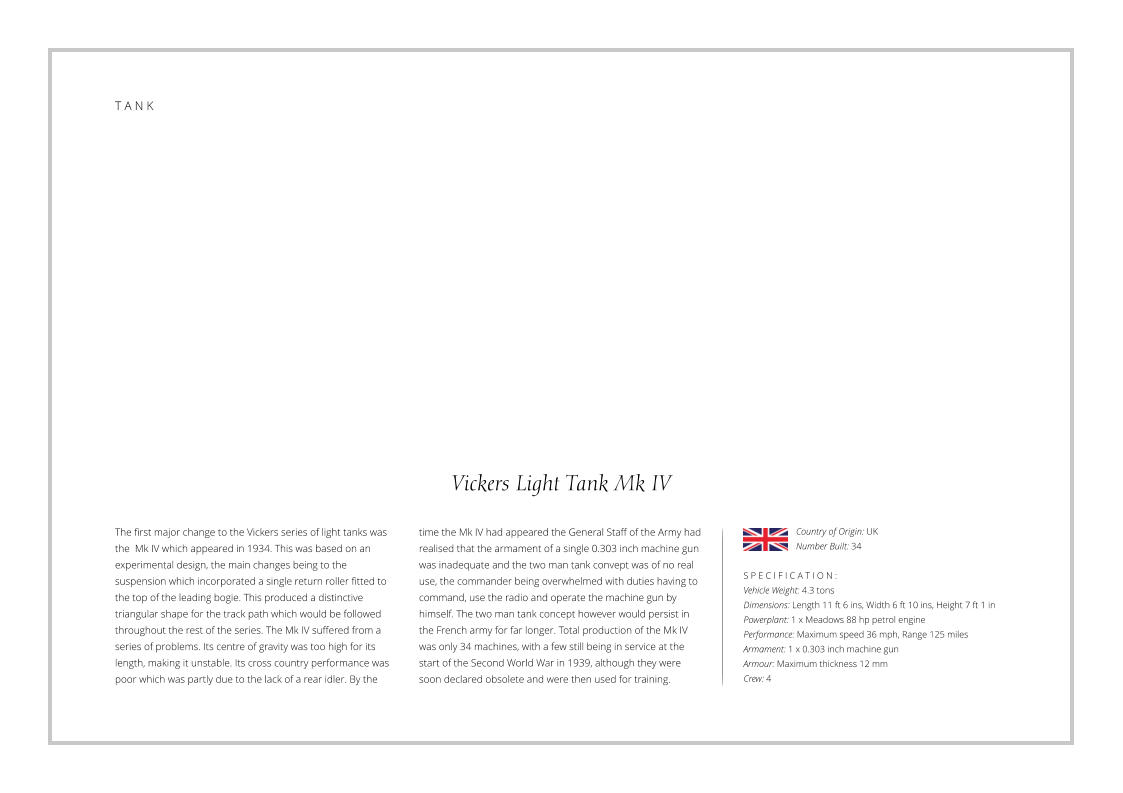
Vickers Light Tank Mk V
The biggest change in the Vickers light tank series came with
the Mk V. This introduced a larger turret and a three man crew,
the extra crewman acting as the gunner and radio operator,
leaving the tank commander to concentrate on his duties
which improved the effectiveness of the tank, especially if he
was the troop commander. To achieve the space the hull was
lengthened which increased the tanks weight by half a ton, this
in turn caused a drop in performance which reduced the top
speed to 32 mph. The armament was also improved with a 0.5
inch Vickers machine gun being added co-axially alongside the
S P E C I F I C A T I O N :
Vehicle Weight: 4.8 tons
Dimensions: Length 13 ft, Width 6 ft 10 ins, Height 7 ft 4 ins
Powerplant: 1 x Meadows 88 hp petrol engine
Performance: Maximum speed 32 mph, Range 125 miles
Armament: 1 x 0.303 inch and 1 x 0.5 inch Vickers machine guns
Armour: Maximum thickness 12 mm
Crew: 3
existing 0.303 inch weapon, giving the Mk V a reasonable
capability against other light tanks and soft vehicles. A total of
twenty-two were built in 1936, with the first twelve vehicles
being issued to the 1st Battalion of the Royal Tank Corps (R.T.C.)
for service trials. A team from Vickers were also present for the
trials where the high level of co-operation between the Army
and the manufacturers soon identified several problems with
the tank. A number of improvements were introduced to the
remaining production vehicles that made them acceptable for
the R.T.C. which would lead to the Mk VI.
Country of Origin: UK
Number Built: 22
T A N K

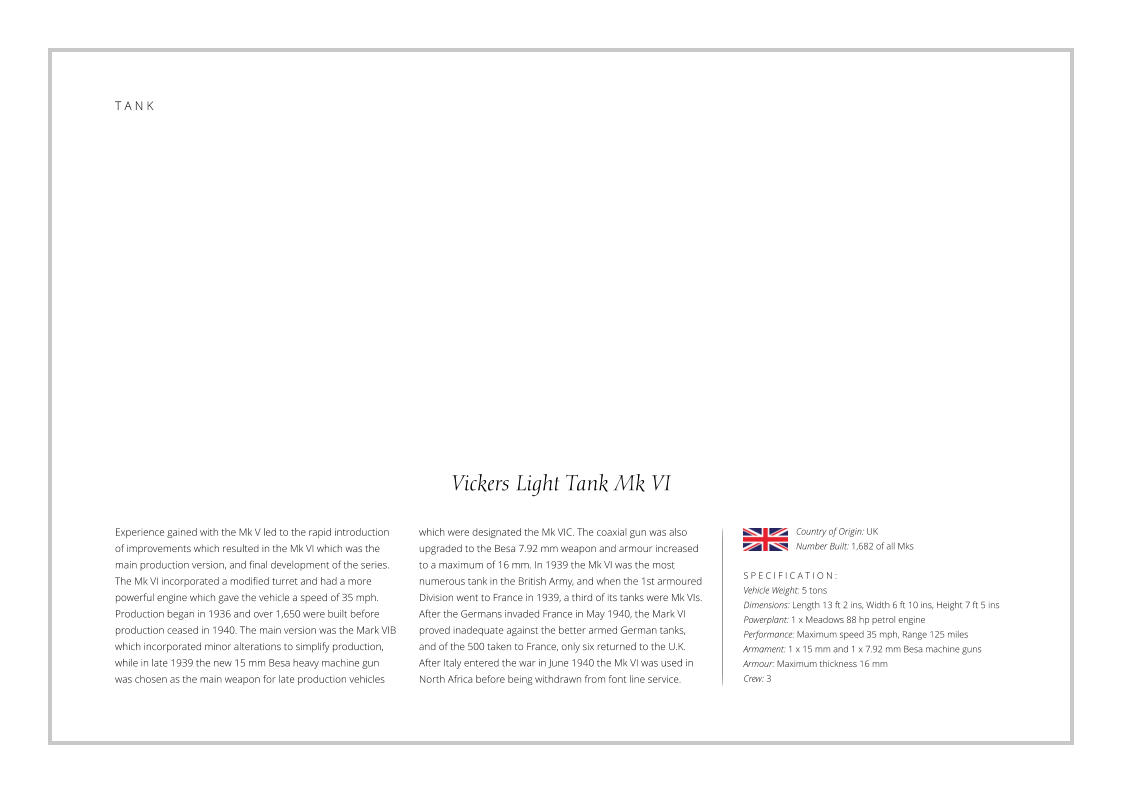
Vickers Light Tank Mk VIC
Experience gained with the Mk V led to the rapid introduction
of improvements which resulted in the Mk VI which was the
main production version, and final development of the series.
The Mk VI incorporated a modified turret and had a more
powerful engine which gave the vehicle a speed of 35 mph.
Production began in 1936 and over 1,650 were built before
production ceased in 1940. The main version was the Mark VIB
which incorporated minor alterations to simplify production,
while in late 1939 the new 15 mm Besa heavy machine gun
was chosen as the main weapon for late production vehicles
S P E C I F I C A T I O N :
Vehicle Weight: 5 tons
Dimensions: Length 13 ft 2 ins, Width 6 ft 10 ins, Height 7 ft 5 ins
Powerplant: 1 x Meadows 88 hp petrol engine
Performance: Maximum speed 35 mph, Range 125 miles
Armament: 1 x 15 mm and 1 x 7.92 mm Besa machine guns
Armour: Maximum thickness 16 mm
Crew: 3
which were designated the Mk VIC. The coaxial gun was also
upgraded to the Besa 7.92 mm weapon and armour increased
to a maximum of 16 mm. In 1939 the Mk VI was the most
numerous tank in the British Army, and when the 1st armoured
Division went to France in 1939, a third of its tanks were Mk VIs.
After the Germans invaded France in May 1940, the Mark VI
proved inadequate against the better armed German tanks,
and of the 500 taken to France, only six returned to the U.K.
After Italy entered the war in June 1940 the Mk VI was used in
North Africa before being withdrawn from font line service.

Country of Origin: UK
Number Built: 1,682 of all Mks
T A N K


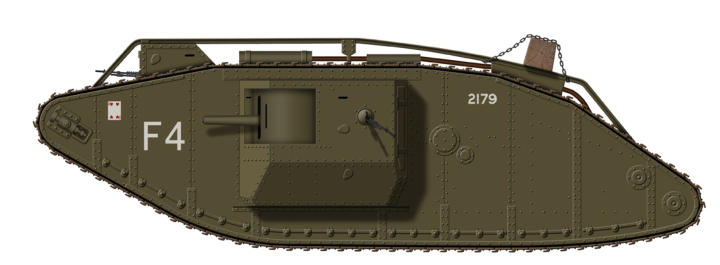
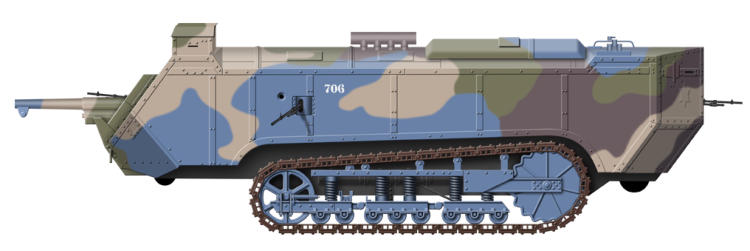
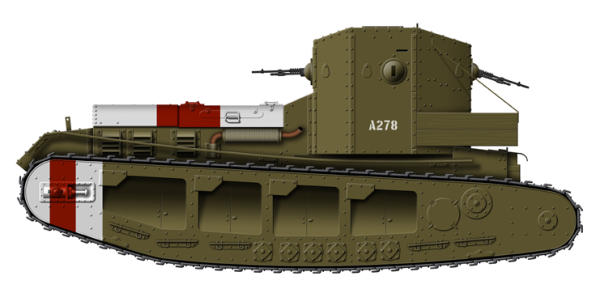
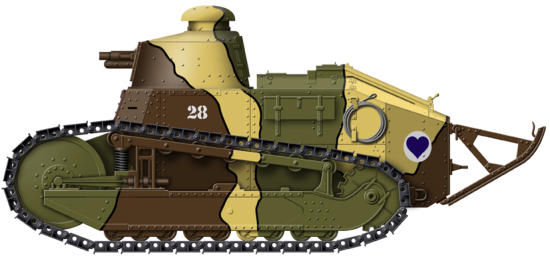

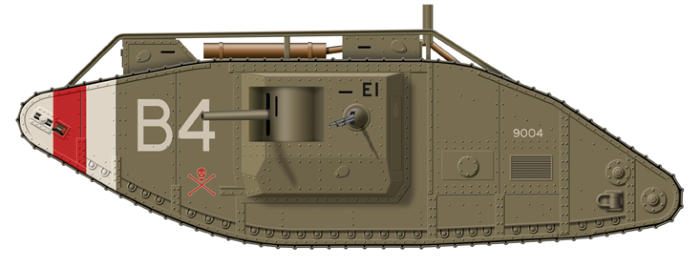
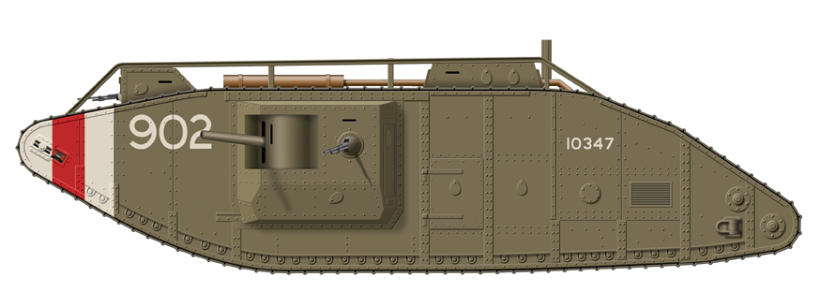

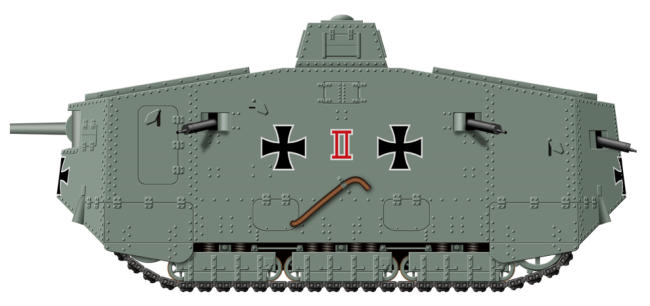
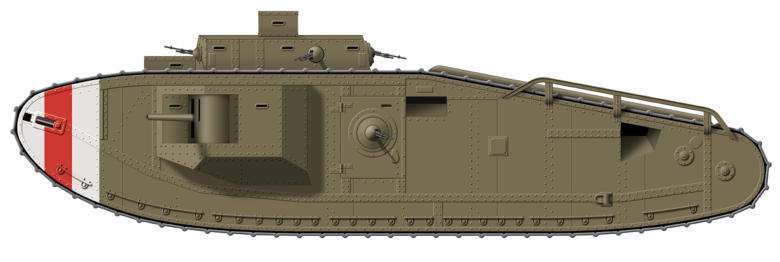
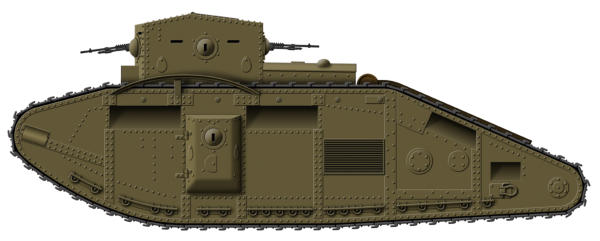
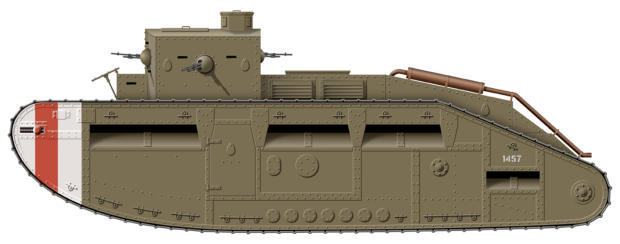
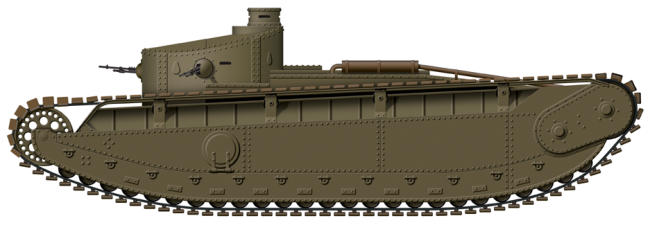
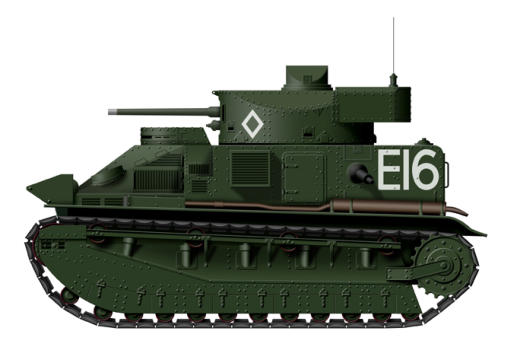
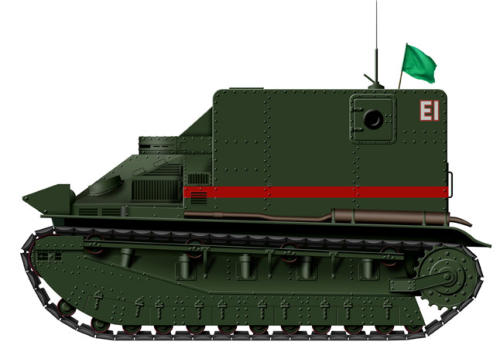
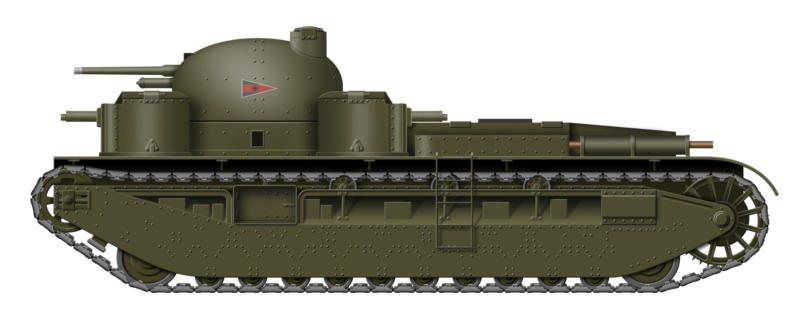
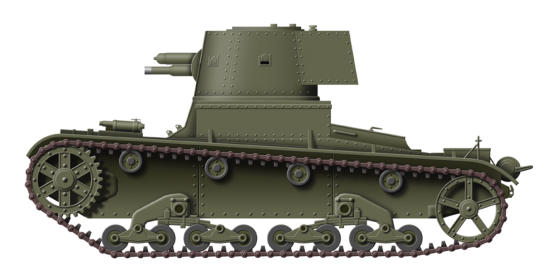

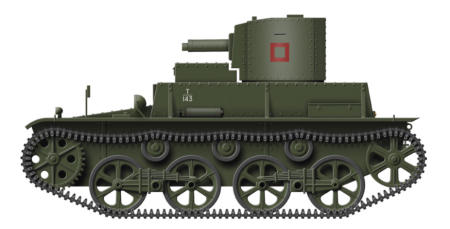
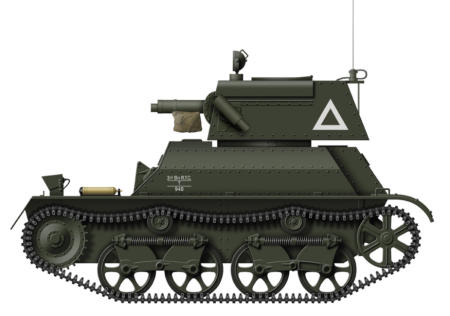
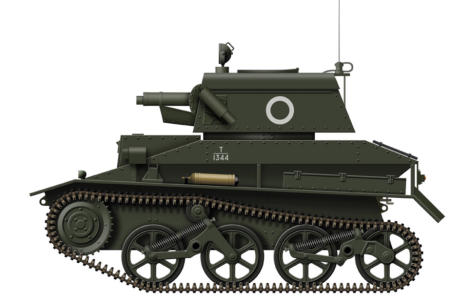
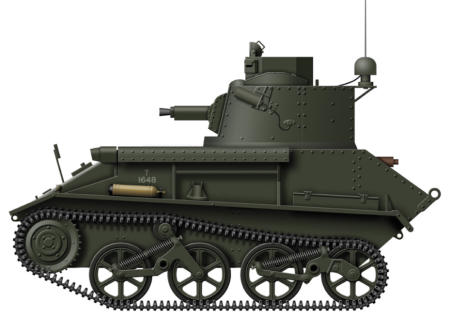
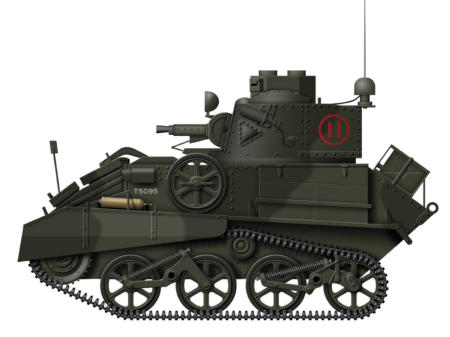
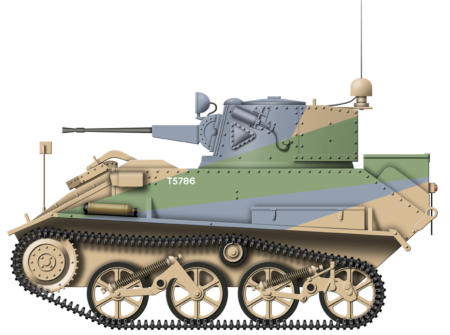








Pages







